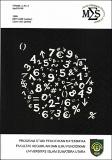| dc.contributor.author | Sinaga, Christa Voni Roulina | |
| dc.date.accessioned | 2018-06-26T09:34:49Z | |
| dc.date.available | 2018-06-26T09:34:49Z | |
| dc.date.issued | 2018-04-01 | |
| dc.identifier.issn | 2579-6550 (online) | |
| dc.identifier.issn | 2528-4363 (print) | |
| dc.identifier.uri | http://repository.uhn.ac.id/handle/123456789/1404 | |
| dc.description | Abstrak. Tujuan penelitian ini adalah: (1) mendeskripsikan tingkat kemampuan
komunikasi matematis siswa dalam pembelajaran berbasis masalah; (2) mendeskripsikan
aktivitas aktif siswa selama proses pembelajaran dalam pembelajaran berbasis masalah
dan (3) mendeskripsikan respon siswa terhadap komponen dalam proses pembelajaran
berbasis masalah. Jenis penelitian ini adalah pengembangan. Populasi dalam penelitian
ini adalah seluruh siswa SMP N 1 Gunung Malela, dan sampelnya dipilih secara acak
yaitu VII-3 dan VII-4 yang masing- masing berjumlah 32 orang. Instrumen yang
digunakan terdiri dari tes komunikasi matematik siswa yang berbentuk uraian. Instrumen
tersebut dinyatakan telah memenuhi syarat validasi serta memiliki koefisien realibilitas
pre-tes dan pos-tes 0,81 dan 0,62. Hasil penelitian menunjukkan bahwa: (1) tingkat
ketercapaian kemampuan komunikasi matematis siswa dalam pembelajaran berbasis
masalah yaitu secara klasikal sebesar 87,50% sedangkan peningkatan kemampuan
komunikasi matematis siswa pada ujicoba I yaitu 2,73 meningkat menjadi 3,05 pada
ujicoba II. Aspek kemampuan komunikasi matematis yang paling tinggi peningkatannya
adalah pada aspek menggambar; (2) aktivitas aktif siswa selama proses pembelajaran
dalam pembelajaran berbasis masalah sudah berada pada kriteria batasan keefektifan
pembelajaran; dan (3) respon siswa terhadap komponen dalam proses pembelajaran
berbasis masalah sudah menunjukkan respon yang positip.Peneliti menyarankan agar
pembelajaran berbasis masalah menjadi alternatif bagi guru dalam meningkatkan
kemampuan komunikasi matematis siswa. | en_US |
| dc.description.abstract | Abstract. The aims of this research is: (1) describe the level of mastery learning and
increasing students’ mathematical communication ability with problem-based learning,
(2) describe students’ activity during the learing process with problem-based learning,
and (3) describe students’ response to the component during problem-based learning.
This research is development research. The population of this research are all of students
in SMP N 1 Gunung Malela, and the sample chosen is random with VII-3 and VII-4 with
32 students for each class. The instrument used consisted of a test mathematical
communication ability of student in description form. The instrumen has been declared
eligible validation and had coefisien reability pre-tes and pos-tes 0,81 and 0,62. The
results of this research shown that: (1) the level of students’ mastery learning
mathematical communication ability in the classical is 87,50% while the increasing of
students’ mathematiucal communication abilityin first trial 2,73 increase to 3,05 in the
second trial. The most increasing aspect from mathematical communication ability is
drawing, (2) students’ activity during learing process with problem based learning has
on efektive criteria, and (3) students’ response to the component during problem-based
learning has a positive respons. The research suggests to use problem based learning as
the alternative way for teacher to increase students mathematical communication
abilities. | en_US |
| dc.language.iso | en | en_US |
| dc.publisher | MES (Journal of Mathematics Education and Science ) | en_US |
| dc.relation.ispartofseries | Vol. 3;No. 2 | |
| dc.subject | Problem Based Learning | en_US |
| dc.subject | Mathematical Communication Ability | en_US |
| dc.title | PENGEMBANGAN PERANGKAT PEMBELAJARAN BERDASARKAN PEMBELAJARAN BERBASIS MASALAH UNTUK MENINGKATKAN KEMAMPUAN KOMUNIKASI MATEMATIS SISWA SMP NEGERI 1 GUNUNG MALELA | en_US |
| dc.type | Article | en_US |

